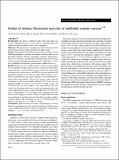| dc.contributor.author | Cassidy, Aedín | en_US |
| dc.contributor.author | Huang, Tianyi | en_US |
| dc.contributor.author | Rice, Megan S | en_US |
| dc.contributor.author | Rimm, Eric B | en_US |
| dc.contributor.author | Tworoger, Shelley S | en_US |
| dc.date.accessioned | 2014-11-03T17:38:29Z | |
| dc.date.issued | 2014 | en_US |
| dc.identifier.citation | Cassidy, Aedín, Tianyi Huang, Megan S Rice, Eric B Rimm, and Shelley S Tworoger. 2014. “Intake of dietary flavonoids and risk of epithelial ovarian cancer1234.” The American Journal of Clinical Nutrition 100 (5): 1344-1351. doi:10.3945/ajcn.114.088708. http://dx.doi.org/10.3945/ajcn.114.088708. | en |
| dc.identifier.issn | 0002-9165 | en |
| dc.identifier.uri | http://nrs.harvard.edu/urn-3:HUL.InstRepos:13347427 | |
| dc.description.abstract | Background: The impact of different dietary flavonoid subclasses on risk of epithelial ovarian cancer is unclear, with limited previous studies that have focused on only a few compounds. Objective: We prospectively examined associations between habitual flavonoid subclass intake and risk of ovarian cancer. Design: We followed 171,940 Nurses’ Health Study and Nurses’ Health Study II participants to examine associations between intakes of total flavonoids and their subclasses (flavanones, flavonols, anthocyanins, flavan-3-ols, flavones, and polymeric flavonoids) and risk of ovarian cancer by using Cox proportional hazards models. Intake was calculated from validated food-frequency questionnaires collected every 4 y. Results: During 16–22 y of follow-up, 723 cases of ovarian cancer were confirmed through medical records. In pooled multivariate-adjusted analyses, total flavonoids were not statistically significantly associated with ovarian cancer risk (HR for the top compared with the bottom quintile: 0.85; 95% CI: 0.66, 1.09; P-trend = 0.17). However, participants in the highest quintiles of flavonol and flavanone intakes had modestly lower risk of ovarian cancer than did participants in the lowest quintile, although the P-trend was not significant [HRs: 0.76 (95% CI: 0.59, 0.98; P-trend = 0.11) and 0.79 (95% CI: 0.63,1.00; P-trend = 0.26), respectively]. The association for flavanone intake was stronger for serous invasive and poorly differentiated tumors (comparable HR: 0.68; 95% CI: 0.50, 0.92; P-heterogeneity = 0.10, P-trend = 0.07) compared with nonserous and less-aggressive tumors. Intakes of other subclasses were not significantly associated with risk. In food-based analyses used to compare subjects who consumed >1 and ≤1 cup black tea/d, the HR was 0.68 (95% CI: 0.51, 0.90; P < 0.01). Conclusions: Higher intakes of flavonols and flavanones as well as black tea consumption may be associated with lower risk of ovarian cancer. Additional prospective studies are required to confirm these findings. | en |
| dc.language.iso | en_US | en |
| dc.publisher | American Society for Nutrition | en |
| dc.relation.isversionof | doi:10.3945/ajcn.114.088708 | en |
| dc.relation.hasversion | http://www.ncbi.nlm.nih.gov/pmc/articles/PMC4196485/pdf/ | en |
| dash.license | LAA | en_US |
| dc.title | Intake of dietary flavonoids and risk of epithelial ovarian cancer1234 | en |
| dc.type | Journal Article | en_US |
| dc.description.version | Version of Record | en |
| dc.relation.journal | The American Journal of Clinical Nutrition | en |
| dash.depositing.author | Cassidy, Aedín | en_US |
| dc.date.available | 2014-11-03T17:38:29Z | |
| dc.identifier.doi | 10.3945/ajcn.114.088708 | * |
| dash.contributor.affiliated | Cassidy, Aedin | |
| dash.contributor.affiliated | Rice, Megan | |
| dash.contributor.affiliated | Tworoger, Shelley | |
| dash.contributor.affiliated | Rimm, Eric | |


